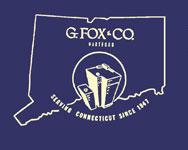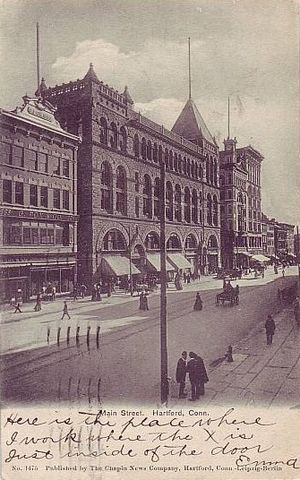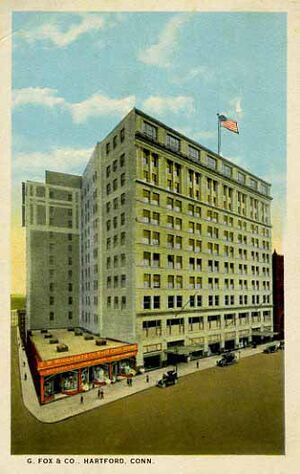- This page was last modified on 17 October 2025, at 10:18. Suggest an edit.
G. Fox & Co. facts for kids
 |
|
| Industry | Retail |
|---|---|
| Fate | Merged with Filene's |
| Successor | Filene's |
| Founded | 1847 |
| Defunct | 1993 |
| Headquarters | Hartford, Connecticut, U.S. |
| Products |
|
| Parent | The May Department Stores Company (1965-1993) |
G. Fox & Co. was a big department store that started in Hartford, Connecticut. It was the biggest privately-owned department store in the country when it was sold in 1965. The new owner was the May Department Stores Company. In 1993, May Department Stores changed all G. Fox stores into Filene's stores. Later, in 2005, Filene's stores became Macy's.
Contents
The Story of G. Fox
How It All Began
G. Fox & Co. began in 1847. Two brothers, Gerson Fox and Isaac Fox, started it. They called their first store "I. & G. Fox Co." It was a small, single room in Hartford, Connecticut. When Isaac left the business, Gerson renamed it G. Fox and Company.
Gerson's son, Moses, joined the store in 1863. He took over in 1880 when Gerson passed away. The early G. Fox store was famous for delivering goods by wheelbarrow! The store grew to five floors. But in January 1917, a fire burned it down.
Moses Fox was 66 at the time. He quickly announced that a new, much bigger store would be built. This new main store opened in 1918. It was located at 960 Main Street in downtown Hartford. People say that customers helped rebuild the store. They paid almost all their old bills, even though they didn't have to. This encouraged Moses Fox to build an 11-story building. It was designed by architect Cass Gilbert.
Moses's daughter, Beatrice Fox Auerbach, and her husband came back to Hartford to help. Beatrice started working with her father after her husband passed away in 1927.
Beatrice Fox Auerbach's Leadership
In 1938, Beatrice Fox Auerbach took charge of the company. She was Gerson's granddaughter. Beatrice helped make G. Fox a very important store in southern New England. Soon after taking over, she made big changes. She added fancy art deco designs inside the store. She also added a special sign above the main entrances.
Mrs. Auerbach became a very respected leader in retail. She was also known for her good work in the Hartford area. She gave money to the University of Hartford, and they named Auerbach Hall after her.
She cared a lot about her employees. She was a pioneer in offering great benefits. These included retirement plans, in-store hospitals, and loans for employees who needed help. Employees also got paid vacations and cheap meals. She even started the Moses Fox Club. This club honored employees who worked there for 25, 40, or 50 years.
Mrs. Auerbach believed strongly in customer service. Employees had to make sure every customer was happy. Service managers could even change a decision made by a merchant to please a customer. No service manager was ever scolded for this. Sometimes, on Christmas Eve, a small team would deliver replacement gifts. They worked until after midnight to make sure gifts were under the tree on time.
Mrs. Auerbach, or "Mrs. A" as staff called her, added more parts to the downtown store. This included a nine-story retail addition. They even moved a huge nine-story warehouse to make space! Other additions included a large warehouse in the 1930s. In the 1960s, a multi-level parking garage was built. This helped customers who drove on the new highways.
Growing the Downtown Store
Through the mid-1900s, the G. Fox store grew only in downtown Hartford. Mrs. Auerbach thought that having other branch stores would make the main store less special. Instead, she expanded the store's phone-order department. They added direct phone lines to many towns in Connecticut, Massachusetts, and Rhode Island. In 1947, G. Fox celebrated its 100th birthday.
The downtown store expanded one last time in 1969. G. Fox took over parts of the nearby Cheney Building. This building was designed by Henry Hobson Richardson. It used to house another local department store.
The G. Fox main store was famous for fun things for customers. They had a big walk-through Christmas display. There was also a talking myna bird in a huge cage on the fifth floor! The store was also one of the first to show home furniture in real room settings. This included kitchens, living rooms, and bedrooms. There were two restaurants on the second floor. One was a lunch bar, and the other, the Connecticut Room, was more elegant.
May Department Stores Take Over
After the store was sold to the May Department Stores Company in 1965, G. Fox started to grow outside Hartford. They built their first branch store in 1969 in Waterbury, Connecticut. This started a plan to build 12 branch stores. This continued until the chain became part of May Company's Filene's division in 1992. Because of this change, and a tough economy, the main store in Hartford closed on January 29, 1993.
Before the merger with Filene's, two more G. Fox stores were planned. One was in Albany, New York, and the other in Stamford, Connecticut. The Albany store opened as a Filene's in 1994. The Stamford store was never built.
The Store Closes
On February 1, 1993, the remaining G. Fox & Co. stores were renamed Filene's. Then, on September 9, 2006, most of those stores became Macy's. This happened after the May Company joined with Federated Department Stores in 2005.
After being empty for almost ten years, the downtown Hartford G. Fox building reopened in 2002. It is now a building with different uses, called 960 Main. It has shops, offices, and meeting rooms. One room is called the "Gershon Fox Room," honoring one of the founders. The building is also home to the new campus for Capital Community College. The renovation kept many of the old art deco details. A new, larger parking garage was also built nearby.
The building is listed on the National Register of Historic Places.
|


